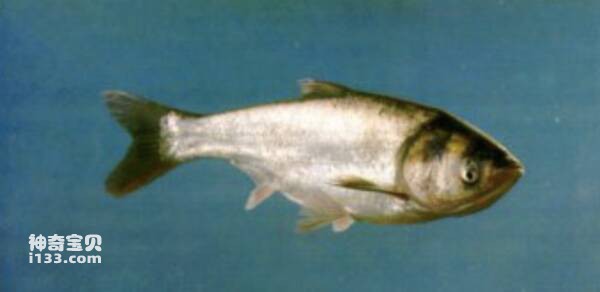Silver carp (Hypophthalmichthys molitrix) belongs to the order Cypriniformes, family Cyprinidae, subfamily Hypophthalmichthys, and genus Hypophthalmichthys. Commonly known as: silver carp, silver carp, edge fish. English name: Silver carp, Silver loweye carp.
The side of the body is flat and the head is larger, but far smaller than that of the bighead carp. The mouth is wide, in a terminal position, with the lower jaw slightly inclined upward. The gills are specialized and unite with each other to form porous membranous sheets. There are spiral-shaped epibranchial organs in the upper part of the oropharyngeal cavity. The eyes are small, set low, and have no beard. The hypopharyngeal teeth are spoon-shaped and flat, with feathery texture on the tooth surface and small scales. There are developed cortical ventral ribs from the throat to the anus. The end of the pectoral fin extends only to the origin of the pelvic fin or later. The body is silvery white, and each fin is grayish white.

It lives in the middle and upper layers of water bodies. It is very active and will jump out of the water when it is startled. Feeds on phytoplankton. Sexual maturity is reached at age 3. There are more broodstock from late April to June. When the water temperature reaches above 18°C, the river water rises or the flow speed intensifies, they breed in river sections with rapids and swirling water. Young fish take the initiative to swim into river bays or lakes in search of food. After spawning, broodstock often enter lakes with abundant food to feed and fatten. In winter, when the lake water drops, mature individuals return to the depths of the riverbed of the main stream to overwinter; most immature individuals overwinter in deep waters of affiliated water bodies such as lakes. Winter is in a less active state.
Silver carp is widely distributed in eastern Asia and can be found everywhere in major river systems in my country. This fish grows quickly, from 2 to 3 years old, its weight can increase from 1 kg to 4 kg, and the largest individual can reach 40 kg. Natural yields are high. At the same time, silver carp's food is phytoplankton, so it has become a top-quality fish for raising fish. It has always been listed as one of the "four major fish" for freshwater aquaculture in my country.
In the Nandu River in Hainan Island, my country, and the Hongshui River system in Vietnam, another species of giant silver carp (Hypophthalmichthys harmandi) inhabits. It looks exactly like silver carp, with a body slightly wider than silver carp and a higher bulge on the back. The main difference between the two is: silver carp has 91-124 lateral line scales, and the anal fin has 11-14 branched fins; while the large scale silver carp has larger scales than silver carp, with 78-88 lateral line scales and anal branched fins. There are 15 strips. Silver carp mostly inhabit open water bodies with slow water flow, fertile water quality and abundant plankton. It dives in deep water during the day and feeds on plankton at night. Female fish can reach sexual maturity at the age of 2, while males can reach sexual maturity at the earliest age of 1 winter. The reproductive period is from May to June, sometimes extending to mid-August. Their living habits and feeding habits are similar to those of silver carp, with the largest individual reaching 25 kilograms. Because of its fast growth, large fatness, and high content quality, it has become an important breeding and fishing target in Songtao Reservoir, Hainan Island.
The nutritional composition of silver carp muscle changes with body length and season. The range of changes is: water accounts for 60.3-80.9%, protein 15.3-18.6%, fat 2.0-20.8%, ash 1.0-1.4%, nitrogen-free extract 0.2 -1.7%. The biochemical composition of fish muscles also changes with the growth and development of fish. When the water content gradually decreases, protein and fat gradually increase. There are 20 types of fatty acids in silver carp muscle fat, including 4 saturated acids, 3 monoenoic acids, 3 dienoic acids, 9 trienoic acids, and 1 tetraenoic acid, with a carbon chain length between 12 and 20. . The percentage content of saturated fatty acids is lower than that of unsaturated fatty acids. The content of saturated fatty acids increases with the growth of fish body, while the content of unsaturated fatty acids decreases with the growth of fish body.
In addition to protein and fat, it also contains 0.8 grams of sugar per 100 grams of edible portion, 117-123 kcal of calories, 22-31 mg of calcium, 86-167 mg of phosphorus, 1.2-13.3 mg of iron, and 0.04 mg of thiamine. , riboflavin 0.21 mg, niacin 2.1 mg, relatively rich in nutrients.
Its muscles are used for medicinal purposes. It is sweet in taste and warm in nature. It has the function of warming and replenishing qi. It is mainly used to treat chronic illness, physical weakness, loss of appetite, dizziness and fatigue. Bile is poisonous, and swallowing fish bile often causes poisoning; the symptoms of poisoning are the same as those of grass carp, carp, etc. There is currently no special treatment for this, so you should pay attention and do not swallow fish gall to avoid poisoning.
animal tags:
We created this article in conjunction with AI technology, then made sure it was fact-checked and edited by a Animals Top editor.